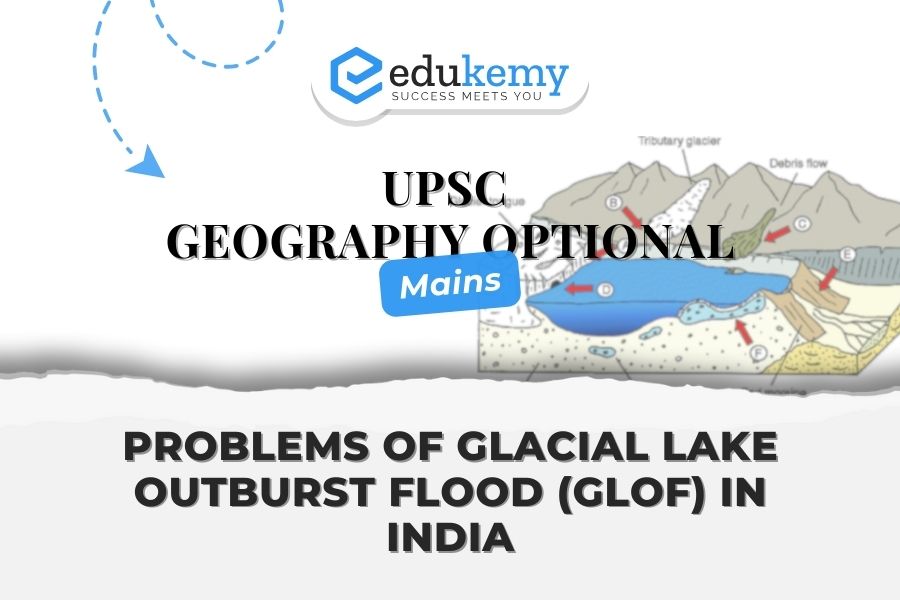
Explore the challenges posed by Glacial Lake Outburst Floods (GLOFs) in India. Delve into the risks associated with the rapid melting of glaciers due to climate change, leading to the formation of unstable glacial lakes. Analyze the potential consequences of GLOFs, including flash floods, erosion, and destruction of infrastructure in vulnerable mountainous regions. Understand the implications for downstream communities, livelihoods, and ecosystems dependent on glacial meltwater. Examine the complexities of monitoring, early warning systems, and disaster preparedness to mitigate the impact of GLOFs. Gain insights into the need for integrated approaches to climate adaptation, glacier management, and risk reduction strategies in addressing the threats posed by GLOFs in India’s Himalayan regions.
Contents
Answer:
Introduction:
Glacial Lake Outburst Flood (GLOF) refers to the sudden release of a significant amount of water from a glacier-dammed lake, often triggered by events like avalanches, earthquakes, or glacier melting. In India, the Himalayan region is particularly susceptible to GLOFs due to its numerous glaciers and glacial lakes.
Body:
Problems of Glacial Lake Outburst Flood (GLOF) in India.
- Melting glaciers: Rapid glacier melting due to climate change increases the volume of water stored in glacial lakes, elevating the risk of GLOFs.
- For example, the retreat of Gangotri Glacier in Uttarakhand has led to the formation of large glacial lakes, heightening the threat of GLOFs.
- Fragile ecosystems: GLOFs can devastate fragile mountain ecosystems, impacting biodiversity and livelihoods.
- In regions like Sikkim, where glacial lakes are common, the loss of biodiversity due to GLOFs can have long-lasting ecological consequences.
- Infrastructure damage: GLOFs can cause extensive damage to infrastructure such as roads, bridges, and hydropower projects.
- For instance, the 2013 Uttarakhand floods, triggered by GLOFs, resulted in the destruction of roads and bridges, hampering rescue and relief efforts.
- Loss of lives and displacement: GLOFs pose a significant threat to human lives, with the potential to cause fatalities and large-scale displacement.
- In Himachal Pradesh, the 2015 GLOF in the Chorabari Lake led to the tragic loss of lives and displacement of communities living downstream.
- Impact on water resources: GLOFs can contaminate freshwater sources downstream, affecting water quality and availability for drinking and irrigation purposes.
- The 2019 GLOF in Arunachal Pradesh contaminated water sources, posing health risks to communities downstream.
- Economic repercussions: GLOFs can have severe economic impacts, including loss of property, livelihoods, and tourism revenue.
- In Ladakh, the 2010 GLOF in the Phuktal River valley caused extensive damage to agricultural land and infrastructure, disrupting local economies.
- Limited early warning systems: Inadequate early warning systems exacerbate the vulnerability of communities to GLOFs.
- Many remote areas in the Himalayas lack the necessary infrastructure for timely monitoring and warning dissemination, increasing the risk of casualties and damage.
- Climate change exacerbation: The increasing frequency and intensity of GLOFs in India are closely linked to climate change, which further exacerbates the vulnerability of mountain communities.
- Without effective climate change mitigation measures, the risk of GLOFs is likely to escalate in the future.
Conclusion:
To mitigate the problems associated with GLOFs in India, concerted efforts are needed at the national, regional, and local levels. This includes implementing robust early warning systems, conducting risk assessments, promoting sustainable land use practices, and enhancing international cooperation for glacier monitoring and research.
In case you still have your doubts, contact us on 9811333901.
For UPSC Prelims Resources, Click here
For Daily Updates and Study Material:
Join our Telegram Channel – Edukemy for IAS
- 1. Learn through Videos – here
- 2. Be Exam Ready by Practicing Daily MCQs – here
- 3. Daily Newsletter – Get all your Current Affairs Covered – here
- 4. Mains Answer Writing Practice – here

